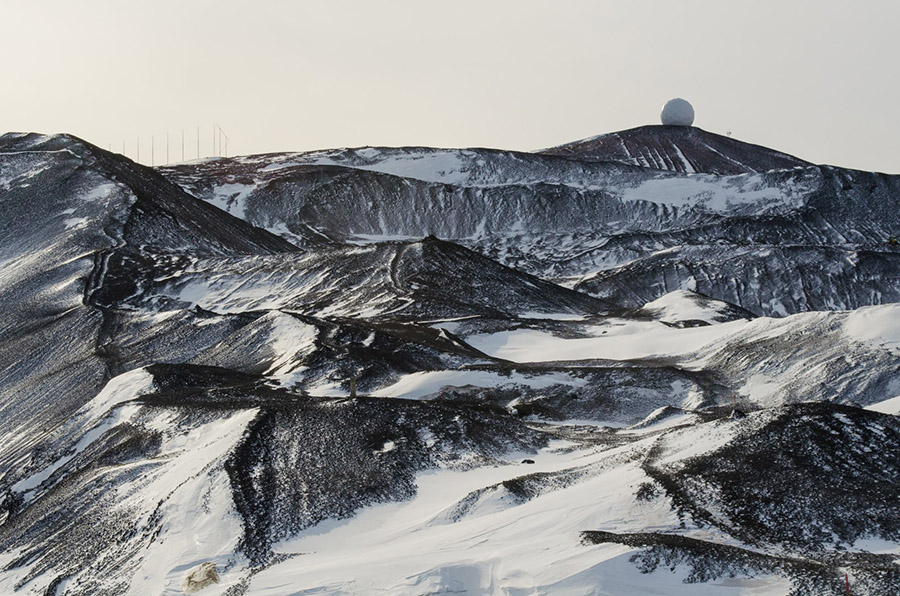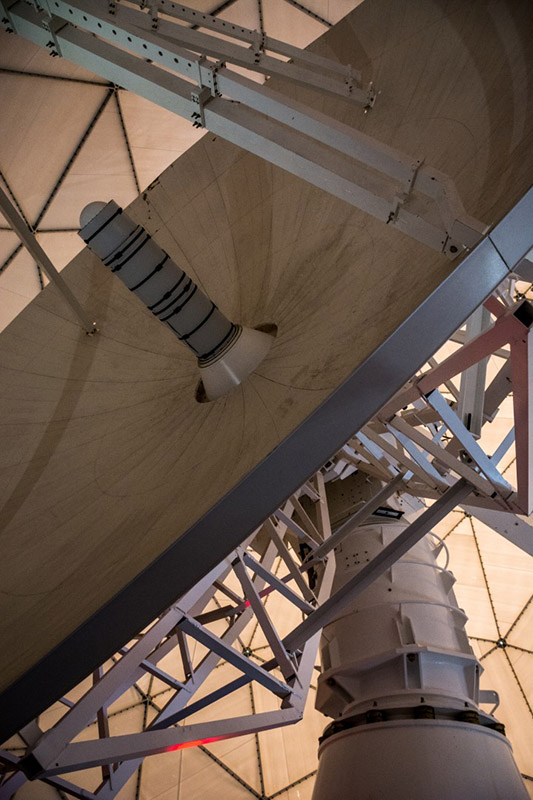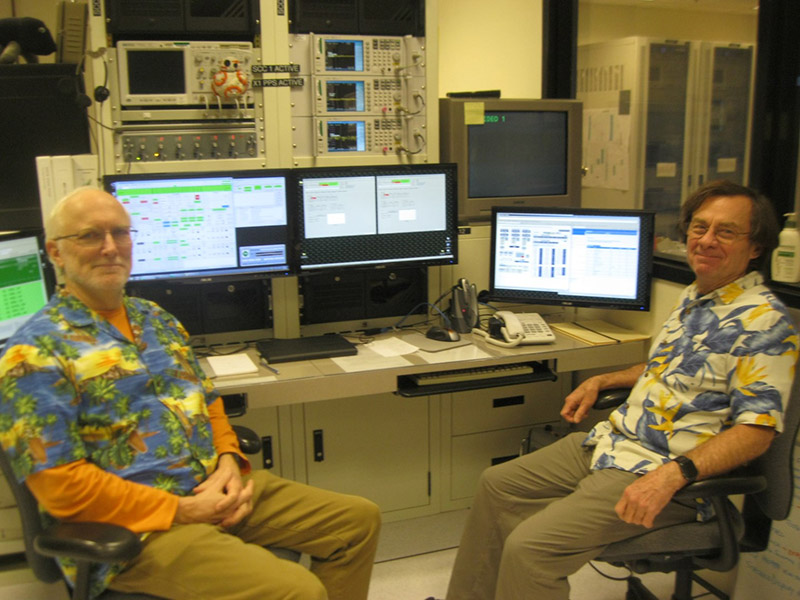
Photo Credit: Mike Lucibella |
Sometimes referred to as “the Golf Ball,” the Radome of the McMurdo Ground station sits atop the hill overlooking the station. |
GRACE-FO to McMurdo Ground Station
Why McMurdo Station’s Strategic Location Makes it Crucial for Downloading Satellite Data
By Elizabeth Delaquess
Posted August 7, 2018
Atop the hill overlooking McMurdo Station sits what, at first glance, looks like a giant golf ball. The huge structure, or radome, shelters a 10-meter satellite dish that collects data from polar-orbiting satellites passing overhead. Although it’s an unassuming building, the equipment inside plays a vital role in satellite communications for science, most recently in a mission to keeps tabs on water levels around the globe, including water lost in the retreat of the continent’s ice sheets.

Photo Credit: Mike Lucibella
The McMurdo Ground Station is only one of two Near Earth Network receiving stations in Antarctica and critical for downlinking data from polar orbiting satellites.
Technicians at the McMurdo Ground Station (MGS) were busy in late May for the launch of a set of NASA satellites known as the Gravity Recovery and Climate Experiment (GRACE), the newest satellites tracked at McMurdo. MGS plays a key role in transmitting from GRACE and other data from orbit to researchers on the ground.
The GRACE-FO (“follow-on”) mission launched May 23 of this year and picks up where the older satellites left off. It is expected to run for at least five years.
GRACE detects changes in Earth’s gravity field to measure the mass of water below, including what’s stored in glaciers, oceans, rivers and even the water soaked into soil after a rain shower. These groundwater measurements across the planet will help scientists better understand long term effects of climate change.
The original two GRACE missions were launched in 2002 and operated until the pair of satellites ran out of fuel in 2017, three times longer than expected. The GRACE-FO satellites, which are a joint project of NASA and the German Research Centre for Geosciences, were launched from Vandenberg Air Force Base in Southern California. MGS played a crucial role in this mission, as it was the first ground station in the “Near Earth Network,” one of a dozen stations worldwide that tracks satellites in low-Earth orbit, to receive a signal from the satellite once it reached orbit.

Photo Credit: Mike Lucibella
Inside the radome, the satellite dish receives data from about a dozen NASA satellites.
Even with months of preparation, the first few minutes after the launch were nerve-wracking.
Rex Cotten, one of the technicians working at the ground station this Antarctic winter cited just one example of what could go wrong in such a complex operation, “you could have a perfect launch, but if the solar panels won’t unfold, the mission could be lost. Everything has to work.”
The GRACE-FO launch was successful and both satellites passed over MGS exactly as predicted. McMurdo’s location where polar orbits converge and the fact that the GRACE-FO satellites pass over McMurdo every 90 minutes, and means MGS will pick up more data from passes of GRACE than other Near Earth Network stations nearer the equator.
Because their location allows them to track so many satellite passes, ground stations like the one at McMurdo are critical to mission success and the scientific research.

Photo Credit: Elizabeth Delaquess
Rex Cotten (left) and Roy Funk sit at a computer monitor as the ground station receives data from orbiting satellites.
MGS began operations in 1996 as a partnership with the Canadian Space Agency as part of a project to map Antarctica. There is only one other Near Earth Network station in Antarctica, operated on the other side the continent from McMurdo by Norway’s Troll Station. Other polar ground stations are located in the northern hemisphere, at Svalbard, Norway, and Fairbanks, Alaska. Though some of these ground stations have more dishes, the dish at McMurdo tracks the most satellite passes for a single dish in the Near Earth Network.
The dish tracks roughly 180 orbits every week, collecting “housekeeping” measurements like battery life, voltages, and equipment temperatures, as well as data used for scientific research. MGS doesn’t interpret any of the data, but redirects it to where it needs to go. Adjacent to the MGS control room is a sterile room with rows of electronics racks containing servers and converters that processes the data and sends it to NASA and partner agencies. The engineers working at MGS are there to monitor the flow of data and repair equipment if necessary.
“Most of the time it’s a quiet job, but when it gets exciting, it gets incredibly interesting very fast,” said Raymond Funk, the other of the two MGS technicians working at McMurdo.

Photo Credit: Elizabeth Delaquess
The bank of computers that monitors the data received from the GRACE-FO satellites.
Like many jobs at McMurdo, science-research support comes with challenges unique to the extremely cold climate.
“You often have to tag team stuff,” said Funk, adding that when repairing or replacing a piece of equipment outside, “You have to take your gloves off and have one guy holding a heat gun blowing on your hands to keep your hands warm.”
In addition to supporting scientific research and launch logistics, Funk and Cotten said there are a number of reasons they enjoy working at MGS.
“I like it for the same reason I liked working in ‘telco’,” said Cotten, who worked as a telecommunications technician at McMurdo before joining MGS in 2007. “[In telecommunications] you have the high tech side of things, and then you have the more physical activities, like crawling under dorms to run cable. It’s kind of the same thing here, because we’ll sit here and do computer work and monitor satellite launches, and at the same time, if the motor burns out or something happens on the antenna, you have to go up and fix it, and work with tools. It’s a great variety of work.”









